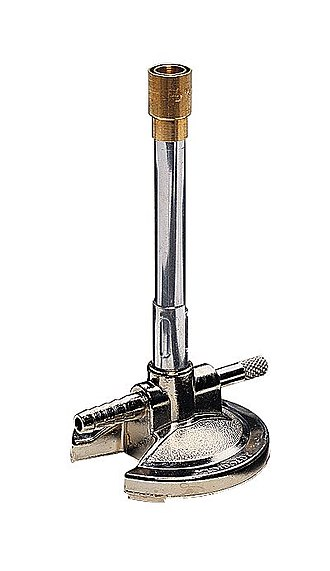A bunsen burner is a kind of gas burner used as laboratory equipment. It produces a single gas flame that can be used for heating, sterilization, and combustion.
Bunsen burner was introduced to the world by Robert Bunsen in 1857.
Index
Working of a Bunsen Burner

The bunsen burner burns a continuous stream of flammable gas such as nitrogen or liquified petroleum or a mixture of both. The hose barb is connected to a gas nozzle with rubber tubing. The gas flows up from the base through a small hole at the bottom of the barrel, directed further upwards. Open slots on the sides of the burner admit air into the stream using the Venturi effect. This allows the top of the burner to be ignited by a flame or spark.
The completeness of the combustion reaction depends on the amount of air mixing with the gas stream.
Insufficient air results in an incomplete, cooler reaction, while a proper amount of air leads to a complete and hotter reaction. This airflow can be controlled by opening and closing the slots.
A hot blue-colored flame is a result of a mixture of a sufficient amount of air with the gas.
A cool yellow-coloured flame is the result of closed slots which give a mixture of gas and ambient air at the point of combustion. This type of flame is often called a safety flame or luminous flame.
It is called luminous due to small soot particles in the flame. This type of flame is considered dirty because it leaves a layer of carbon on while heating.
The hottest part of the flame is the tip of the inner flame, while the coolest part of it is the entire inner flame. The size of the flame can be increased by allowing more gas to enter.
Applications of Bunsen Burner
- Bunsen burner is mostly used in the chemical laboratory for heating purposes.
- It is also used in microbiology laboratories to sterilize pieces of equipment.
FAQs
The two types of flames produced are a yellow flame which is due to a mixture of insufficient amounts of air and gas and a blue flame which is due to a mixture of sufficient amounts of air and gas.
There are other burners existing that follow the same principle. They are Teclu burner, Meker burner, and Tirrill burner.
